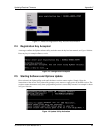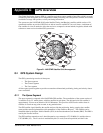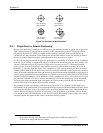
GPS Overview Appendix G
SUPERSTAR II User Manual Rev 3 69
Figure 22: Illustration of Receiver Height Measurements
From the above diagram, and the formula h = H + N, to convert heights between the ellipsoid and geoid we
require the geoid-ellipsoid separation value. This value is not easy to determine. A world-wide model is
generally used to provide these values. NovAtel GPS receivers store this value internally. This model can also
be augmented with local height and gravity information. A more precise geoid model is available from
government survey agencies e.g. U.S. National Geodetic Survey or Geodetic Survey of Canada (see Appendix
D, Standards/References on Page 62).
Why is this important for GPS users?
The above formula is critical for GPS users as they typically obtain ellipsoid heights and need to convert these
into mean sea-level heights. Once this conversion is complete, users can relate their GPS derived heights to
more “usable” mean sea-level heights.
G.3 GPS Positioning
GPS positioning can be categorized as follows:
1. single-point or relative
2. static or kinematic
3. real-time or post-mission data processing
A distinction should be made between accuracy and precision. Accuracy refers to how close an estimate or
measurement is to the true but unknown value; precision refers to how close an estimate is to the mean
(average) estimate. “Accuracy versus Precision” on Page 70 illustrates various relationships between these
two parameters: the true value is "located" at the intersection of the cross-hairs, the centre of the shaded area is
the "location" of the mean estimate, and the radius of the shaded area is a measure of the uncertainty contained
in the estimate.
References:
1 Topography
2 Geoid (mean sea level)
H = Receiver computed height above/below geoid
N = Geoidal Height (undulation)
3 Spheroid (ellipsoid)
h = GPS system computed height above the spheroid
N = h - H


















